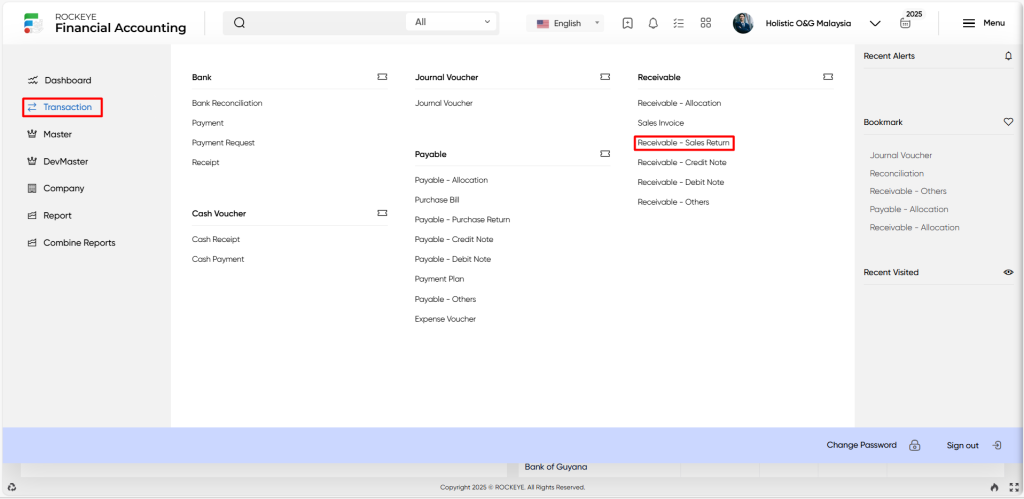Financial Accounting
Receivable Sales Return
Introduction/Purpose:
The process of accepting consumer returns, offering refunds or credits, and reducing accounts receivable is known as receiving sales returns. It supports accounts receivable management and customer interactions by ensuring accurate record-keeping, customer satisfaction, and proper handling of sales returns in financial statements.
Dependency:
- Sales return policy: An established sales return policy establishes the standards and circumstances for accepting consumer returns. It specifies the eligibility requirements, deadlines, and valid justifications for returns.
How To Navigate:
The navigation includes the following steps for viewing the receivable sales return in the Financial Accounting system.

- Click on the transactions tab: The transactions can be accessed by clicking on the transactions tab on the side menu.
- Click on the receivable sales return: The receivable sales return can be accessed by clicking it from the receivable section.
Listing:
A receivable sales return listing in a Financial Accounting system is a feature which provides a list of all sales returns.

- Users can view the following information in the receivable sales return listing
- Voucher and date
- Inv/ref and customer
- Customer and currency
- Exchange rate and taxable
- Net amount and net amount (LC)
- Attachment and status
User can perform the following actions
- Add new: The “Add new” function allows you to create and add new receivable sales returns to the system.
- Show all listing: The “Show all listing” function is to display and update a list or collection of receivable sales returns within a system or interface.
- Clear cache: The “Clear cache” function clears the cached data associated with the receivable sales return.
- More options: The “More options” function provides the user with more actions or functionalities.
- Print records: The “Print records” function allows users to print content by opening a print dialogue or displaying a preview of the content to be printed.
- Search & Quick Search: The “Quick Search” function refers to the option that allows for detailed searches based on multiple parameters, while the ” Search” option allows for short searches based on keywords or selective terms.
Recording & Update:
Add New Receivable Sales Return:

- Choose an option: The “Choose an option CoA” refers to the option where the user must select the chart of accounts with which this specific receivable sales return is related.
- Customer: The “Customer” refers to the name or identity of the customer taking part in the transaction.
- Currency: The “Currency” refers to the type of money used in the transaction.
- Exchange rate and date: The “Exchange rate” refers to the exchange rate applied to convert the transaction amount from one currency to another, while the “Exchange date” refers to the day that the currency exchange rate was determined.
- Prefix voucher number and date: The “Prefix voucher number & date” refers to the reference number allocated to the payment transaction, and the voucher date associated with the transaction
- Billing address: The “Billing address” refers to the address to which the invoice or billing statement for the receivable transaction is mailed/sent.
- Order no. & date: The “Order no & date” refers to a payment transaction that is related to a purchase order, the order number and date represent the request data.
- VAT withheld: The “VAT withheld” refers to the percentage or amount of VAT that is withheld from payments made.
- Due date: The “Due date” refers to which payment for the due transaction is expected to be made.
- Deal master, Profit centre, Cost centre, Quantity, Unit rate, Amount, Tax calculation, Tax group & so on: These terms refer to various details and attributes related to the receivable transaction, such as a transaction description, deal master information, allocation to profit centres or cost centres, quantity, unit rate, amount, tax calculation method, tax group, and other relevant information.
- Attachment, Narration, Tax breakup & Payment summary: These elements provide additional details and supporting information for the receivable transaction, such as attachments of relevant documents, narrations or comments, a tax breakup that shows tax components, and a payment-related information summary.
Users can perform the following actions
- Submit: The “Submit” function allows the user to submit the required information while creating a new receivable sales return.
- Discard: The “Discard” function allows the user to cancel the submission of information provided at the time of creating a new receivable sales return.